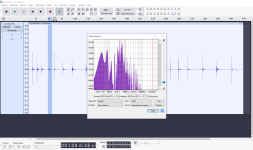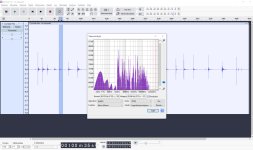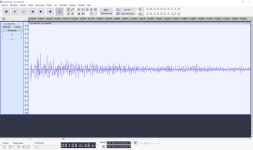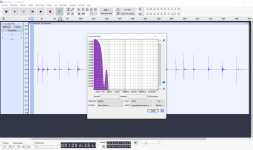Yes, a lot of answers here, the DACS are good a low noise and specifications, but they cannot make the complex pulse fast of the broad spectrum of the cymbal, it will soften the sound.
I did many comparisons with hifi turntable needles and all the metal bells/cymbals , but especially bells have way more realism because it is a mechanical means of reproducing it.
Second problem is the power amplifier and all the rest, most designs cannot properly amplify the whole spectrum without insane phase shifts, and THD and with a RIAA curve like!!! feedback, bootstrapping etc and multiple mirror components are required to correct it but in the final sound it becomes 'smeared' and annoying.
Also it lacks the current in many systems to drive the loudspeakers and the intensity of 100db and down and up, the impulse of the cymbal creates too much THD in the whole system that the decay is destroyed.
The biggest problem is the XO and tweeter, all materials are soft paper or plastics or fabrics, which dampers the strong sharp impulse of the sound, it will sound like a cymbal struck through velvet. It lacks the area and material, so it will never sound like one.
I did many comparisons with hifi turntable needles and all the metal bells/cymbals , but especially bells have way more realism because it is a mechanical means of reproducing it.
Second problem is the power amplifier and all the rest, most designs cannot properly amplify the whole spectrum without insane phase shifts, and THD and with a RIAA curve like!!! feedback, bootstrapping etc and multiple mirror components are required to correct it but in the final sound it becomes 'smeared' and annoying.
Also it lacks the current in many systems to drive the loudspeakers and the intensity of 100db and down and up, the impulse of the cymbal creates too much THD in the whole system that the decay is destroyed.
The biggest problem is the XO and tweeter, all materials are soft paper or plastics or fabrics, which dampers the strong sharp impulse of the sound, it will sound like a cymbal struck through velvet. It lacks the area and material, so it will never sound like one.
Absolutely. Drummers who bask cymbals are a problem both in the studio and live. Drummers who can hit their drums hard but finesse their cymbals get the best sound. Then, when you use compression to mix it, it sounds better. A good drummer mixes themselves and the compression is just icing on the cake.Eww, good drummers have nice balanced sound and controlled dynamics with their kit, while rookies don't.
I've been a recording and live music engineer for 25 years. You're correct here. The root of it is the playing. "You can't polish a turd." When I've had the opportunity to mix good drummers, it all comes together so easily. (Brooks Wackerman comes to mind here).What I mean is dynamics of the playing is on whole another level with a good drummer, natural sounding and fit for the context. Rookies bash on the symbals and wimp on the tomtoms, no dynamics with the beat to really make it groove, and in general play way louder than rest of the band mostly because it's a loud instrument which easily overpowers everyone else in the room, unless the drummer has good control over it, knows how loud or soft any one of the hits need be. When balance is bad, one likely puts more mics to have some control over it later on, but the leakage sounds just bad and end result is overprocessed mess, and it started from the situation in general, or from skill of the drummer.
If producer has better idea, it's likely with the rookie and in general to benefit the song. A good drummer understands how important the kit balance is, also how important the whole band balance is, it's the end result, the song, combination of all, the feel and vibe. Just like any musician with their instrument should.
You're at the mercy of the source. Bad records with bad playing will always be bad. DAC's with low distortion and jitter and an obvious choice but that won't fix any problems at the source. They can only reproduce the source more or less accurately. Sometimes, more accuracy sounds worse!Yes, a lot of answers here, the DACS are good a low noise and specifications, but they cannot make the complex pulse fast of the broad spectrum of the cymbal, it will soften the sound.
Hypex or Purifi Class D is about as good as it gets.I did many comparisons with hifi turntable needles and all the metal bells/cymbals , but especially bells have way more realism because it is a mechanical means of reproducing it.
Second problem is the power amplifier and all the rest, most designs cannot properly amplify the whole spectrum without insane phase shifts, and THD and with a RIAA curve like!!! feedback, bootstrapping etc and multiple mirror components are required to correct it but in the final sound it becomes 'smeared' and annoying.
Also it lacks the current in many systems to drive the loudspeakers and the intensity of 100db and down and up, the impulse of the cymbal creates too much THD in the whole system that the decay is destroyed.
The biggest problem is the XO and tweeter, all materials are soft paper or plastics or fabrics, which dampers the strong sharp impulse of the sound, it will sound like a cymbal struck through velvet. It lacks the area and material, so it will never sound like one.
I certainly appreciate the sentiment here, but I the musicians often like the compressed and produced sound better. I know that to be the case in several situations I have worked in. I love a natural sound for certain types of music, but using some tricks to get the drums to sound bigger and punchier is also cool. Plus, using compression to bring dynamics forward (I know this sounds counterintuitive) can also be cool. So I think there is merit to all of the approaches and there are so many ways to get music across that we can enjoy all of them. Tasteful use of compression is not always unnatural either. But there are many records that have butchered things so I can understand where you're coming from.I want what the musicians create--not someone sitting at a desk "correcting" it. For that matter, I like non-mulitracked recordings where the musicians get to choose (in real time) what they want it to sound like. The phase fidelity is much better,
Phase is certainly an issue with multi-track stuff but good recordings often don't have those phase problems and there are many ways to deal with it naturally by getting the microphones in the right spot. Also, having a good room is important. But I will say that the biggest thing is the drummer and the sound of the kit. Good drummers mix themselves and they fix so many problems. This is why guys like Brooks Wackerman, Josh Freeze, and others are so good.
I can hear multi-tracked music defects in my recordings. The recordings where the musicians are recorded together are the ones that send shivers up my spine with the realism of reproduction.
A big part of "being a good drummer" is also know your set and how to get the right sounds out of it. My favorite drummer of all times, Tony Allen (Fela Kuti's drummer) was an absolute master in that. He could get very powerfull sounds out of his kit wth little movement, and on low level and balance himself so good you probally only need 3 mics to record him, a kickmic and two overheads. There are very few drummers where you can do that, they need to have an absolute control over their drumset. Art Blakey was also such a drummer.
This is Tony Allen in France (where he lived the last part of his life). Note how he plays with little movenent or force, but still got a powerfull and dynamic sound of it. He balances him with the acoustical instruments next to him (so he plays soft). I've seen him do that in Gent also, after a regular concert in a jam in a private house with some local jazz musicians. He did that sometimes, even if he is world famous.
This is Tony Allen in France (where he lived the last part of his life). Note how he plays with little movenent or force, but still got a powerfull and dynamic sound of it. He balances him with the acoustical instruments next to him (so he plays soft). I've seen him do that in Gent also, after a regular concert in a jam in a private house with some local jazz musicians. He did that sometimes, even if he is world famous.
Those are called an ‘Orchestrion’ (Or-kess-tree-ahn) in the U.S.
One of the reasons drummers do not keep their hearing for very long, unless ear protection is used 😉I cant wait to crack it actually. Because that is the life of a cymbal.
Last edited:
Thats sound good, I have three good amplifiers and I am not interested to hear anything else!
I never suggested we would want a speaker to recreate the directivity of an instrument, even if it were possible.You don't need or want a speaker to recreate the directivity of an instrument. Reproduction is based on ambient information being on the recording, and you don't need the same space to exist in the listening room. Reproduction should be able to ignore the room and project beyond it's physical boundaries without them being noticed.
Even if the reproduction is exactly the same as what was recorded, it can only present a reasonable facsimile in a relatively limited portion of the listening room that will give an sonic illusion recreating what the microphones picked up at the particular location where the recording took place.
In terms of the original post's question:
A real cymbal has unusual radiation patterns that shift during the time envelope after each strike, interacting with it's acoustic environment very differently than a loudspeaker's fixed radiation pattern possibly can.Now, I am curious why it was clear that a real instrument was playing and not a loudspeaker.
https://www.soundonsound.com/techniques/analysing-metallic-percussion
Exactly, even though an excellent speaker system can do a good job of reproducing the cymbal sound within the room, the sonic illusion falls apart outside that limited area.Don't forget, a cymbal is a 20" tweeter! 😀
This was made very clear to me a few years ago at the first Capital Audio Fest outside Washington DC. In the evening there a was a live jazz band in a room that was used all day for Hi-Fi gear demos. The difference is cymbal sound between live and reproduced was "striking."
No, it's not just you, most anyone can tell the difference.In 30 years playing in bands, I never heard a speaker completely able to make a cymbal sound real... This is formidable instrument !
But it's me, OK ?
Even with my age and noise induced hearing losses it's still easy for me to hear the difference between the very different radiation patterns between loudspeakers and real cymbals while driving in a car past a live band playing outdoors.
Art
Last edited:
you need everything to reproduce a cymbal, even if you have 20x tweeters and huge towers, the XO or the filtering will completely destroy the transient required through self induction and phase.
you don't need to reproduce 100% of the sound, 10% is ok, the brain will fill the missing gap and believe it is real.
you don't need to reproduce 100% of the sound, 10% is ok, the brain will fill the missing gap and believe it is real.
If anyone wants to hear some real unprocessed cymbal hits, I made some a few years ago for a diyaudio thread. Edited out only one hit for that use through. The whole track with multiple hits in mono is available at: https://www.dropbox.com/scl/fi/zdzl...udio.wav?rlkey=ibhwoa2e655ptcyct9y9pyn1k&dl=0 Recording was done with a Schoeps CMC-641 hypercardioid condenser mic, so not a lot of room sound. Mostly its just one cymbal hit in different ways.
I like a decent compression driver on a Karlson "K-tube" such as the old Transylvania Power Company product - its quite good on high-hat cymbals - maybe more convincing that some horn/WG (?). Perhaps 3 K-tube on top of a speaker could be interesting with drumkits. A Karlson midbass coupler done with a curved reflector (tricky ?) could be musical and punchy.
Some time ago, I was walking on a parking lot and heard music coming from the adjacent building 20 meters away. Its doors were open. What struck me, was that I could hear that the cymbals sounded like the real thing, without being able to see what made the sound. It turned out to be a dance organ. In a large, reverberant room.
For those who do not know what a dance organ is, it is awesome:
Now, I am curious why it was clear that a real instrument was playing and not a loudspeaker.
- Can it be related to an instrument being 'faster' than the same instrument, recorded and played back over a loudspeaker? I do not think this could explain it here, because there only was a mix of reflected sounds to hear.
- Can it be related to directivity pattern? I doubt it. There is no way to distinguish between different directions. All I knew was that sound was coming from some doors 20 meters away.
- Can it be the sound pressure level? Real cymbals are loud. But it was not that loud outside.
- Can it be the dynamics? Real instruments have no compression applied to them. Maybe?
- Can it be the spectral content of the sound? Being outside of the building, I must have heard the power response. Cymbals are quasi-omnidirectional over their full frequency range, while most loudspeakers beam at high frequencies and have a downward trend in their power response. But would not have it been altered to an unknown amount, by the room acoustics?
Any thoughts are appreciated.
Are you saying that the speaker sounded like the real thing?
Cymbals tend to have a very rich waveform with high frequencies (ringing) from their complex vibrations, lots of acoustic power and very fast leading edge transients with a long decay.... meaning they get loud very fast... And they do load the room evenly, so the power decay is nowhere as sharp with distance as a point source loudspeaker - which drops at a 6db rate I think? It drops with the cube of the distance? A line source dipole starts to get closer in acoustic decay over distance but still it's not like the real thing given the large radiating area of the cymbal.
A very similar thing with the drum kit.
Listening to a live drum kit in a room is a very loud experience and the radiation pattern tends to load the room very evenly through the space (OK, perhaps not in an auditorium). I can't think I've ever heard anything recorded that came close.... just facsimiles of the sound.. perhaps with a good PA, you get pretty close but not with a HiFi system -not one I've ever heard at least.
BTW, I use the cymbals as a test of how good a HiFi sounds ( assuming a good recording ).. Mostly to hear the "metallic" nature, speed and decay but not the loudness. The Beatles, Blue Album, A Day In The Life has a good test. After two minutes into the song.... "Woke up, got out of bed"...
No, it won't sound like a real instrument though... but it's a good test of how "fast" a system sounds.
Perhaps, from outside, listening to the audio coming through a door... it did sound to you as if it was live music? Maybe the entire room was being acoustically loaded by that dance organ? Maybe because it was designed to play LOUD and with fast transients?
@weltersys That write up at SoS is very good. Thanks.
Last edited:
If anyone wants to hear some real unprocessed cymbal hits, I made some a few years ago for a diyaudio thread. Edited out only one hit for that use through. The whole track with multiple hits in mono is available at: https://www.dropbox.com/scl/fi/zdzl...udio.wav?rlkey=ibhwoa2e655ptcyct9y9pyn1k&dl=0 Recording was done with a Schoeps CMC-641 hypercardioid condenser mic, so not a lot of room sound. Mostly its just one cymbal hit in different ways.
Here Audacity spectrum analysis of strikes 4 and 5, also ambient noise separately. Notice that dB scale varies!




Hear's a 'nearly famous' music track that is full of cymbals.
You can hear the cymbals, yet they don't sound very real >
You can hear the cymbals, yet they don't sound very real >
- Home
- Loudspeakers
- Multi-Way
- What makes cymbals sound real?